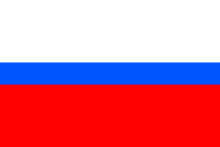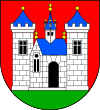Příbram
Příbram (Czech pronunciation: [ˈpr̝̊iːbram]; German: Freiberg in Böhmen, Przibram or Pribram, in the time of the German occupation (1939–1945) Pibrans) is a town in the Central Bohemian Region of the Czech Republic with a population of about 32,500. The town is located on the Litavka river and the foothills of the Brdy Range, 60 km (37 mi) south-west of Prague; the country's capital. The town is well known for its mining history and more recently its new venture into economic restructuring.
Příbram | |
|---|---|
Town | |
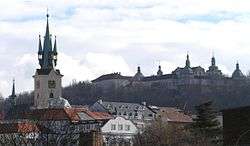 Svatá Hora and the Church of Saint James | |
 Příbram Location in the Czech Republic | |
| Coordinates: 49°41′18″N 14°0′33″E | |
| Country | |
| Region | Central Bohemian |
| District | Příbram |
| First mentioned | 1216 |
| Town privileges | 1579 |
| Government | |
| • Mayor | Jan Konvalinka (ANO) |
| Area | |
| • Total | 33.41 km2 (12.90 sq mi) |
| Elevation | 502 m (1,647 ft) |
| Population (2020-01-01[1]) | |
| • Total | 32,503 |
| • Density | 970/km2 (2,500/sq mi) |
| Time zone | UTC+1 (CET) |
| • Summer (DST) | UTC+2 (CEST) |
| Postal code | 261 01 |
| Website | pribram.eu |
The town is the third largest in the Central Bohemian Region (behind Kladno and Mladá Boleslav) and is a natural administrative and cultural center of the south-western part of the region, although it also tends to be largely influenced by the economy and lifestyle of Prague.
The Svatá Hora ("Holy Mount") pilgrimage site is located just above the town, while the Mining Museum Příbram, including the communist labor camp Vojna memorial is another tourism attraction.
History
From legends to Middle Ages
Several legends mentioning Příbram in the early history of Czech statehood are mentioned in the Annales Bohemorum written by Václav Hájek z Libočan in the first half of the 16th century. The legends talk about princess Libuše's prophecy and the destroying of the Březové Hory mines by Horymír of Neumětely. Both of these mentioned stories also depict the silver mining in the region.
Hájek also explains the name of the town, although his etymology is now believed to be partially fancied, the basics of it is probably true, as the town name is derived from the name of a person, probably the site owner.
Since 1216 (first written mention), the Příbram estate has been owned by Prague bishops and soon received its walls. The town castle was built under Prague archbishop Arnošt of Pardubice. During Hussite wars in the 15th century, Příbram stood on the reformation side, but was captured and pillaged four times by Catholic aristocracy.
Archbishop Zdeněk Zajíc of Hasenburk gave Příbram town privileges, which were confirmed by King Jiří z Poděbrad in 1463, and in 1496 Příbram was named town by King Ladislaus II, as Příbram was passed over to Czech king's hands. The economic state of the town however decreased as the rulers often impledged the town and temporary masters did not care about the town development.
Modern history
.jpg)
Information about the silver and iron mining in Příbram were furthered in mining books from late 16th century survived to present days. In 1579 Rudolf II promoted the reputation of Příbram by naming it the "Royal Mining City". The Thirty Years' War had a large impact on Příbram, lowering the population and causing violent recatholicization that was supported by the growing importance of Holy Mountain, nearby the pilgrimage site.
Since the 17th century the mining boom was followed with the town growth. The town however gave the majority of its mining profit share over in favor of central Vienna government, which soon slowed the development of the town when the silver mining was at its peak at the end of the 18th century.
Five major deep-mines are built in the 18th century in Březové Hory near Příbram, starting with the St. Adalbert mine (Czech: Vojtěšský důl). The Příbram mining district became one of the most modern in Europe in the 19th century, which remained true until the 1920s. Příbram built educational sites and became the seat of central mining authorities and the mining academy. The St. Mary mine (Czech: Mariánský důl) fire in 1892 was a large-scale catastrophe, as 319 miners died. Although the real importance of Příbram mines declined after 1900, the town's reputation as the educational and cultural centre remained high.
Region with strong partisan resistance was around Příbram during World War II. Several prominent citizens participated in the resistance, and many were killed by Nazi occupiers. Student Antonín Stočes, his father and Příbram's gymnasium director Josef Lukeš, were executed in Tábor in the 1942 days following the assassination of Reichsprotektor Reinhard Heydrich. Their story was idealized in Jan Drda's fiction Vyšší princip (English: Higher Principle). General Richard Tesařík,[2] the Hero of the Soviet Union, or legionary Alois Laub, leader of the military resistance group Oliver, executed in Brandenburg in 1945, were born in Příbram.
At the beginning of May 1945, Příbram spontaneously rose up against the occupiers, the Czech authority took formally the power, but the Wehrmacht unit threatened with declaration of martial law. After negotiations, the town was liberated by the Soviet partisan brigade Death of Fascism (Czech: Smrt fašismu, Russian: Смерть фашизма) led by Captain Yevgeny Antonovich Olesinsky. Although the majority of German forces had left the town before the liberation itself, Příbram's surroundings are said to be the place where the last shots of the World War II were fired. German troops trying to leave Soviet zone over the demarcation line were met by partisan units and eventually fought Soviet Army, General von Pückler agreed to a surrender 12 May 1945, four days after the V-E Day.
In 1953,[3][4] the cities of Příbram and Březové Hory were merged - today Březové Hory is part of Příbram called Příbram VI - Březové Hory.
The last epoch of Příbram mining occurred since the 1950s, when the district was opened again for uranite mining, several mines around the town were opened. The industry was included into a program of penal labour that Communist Czechoslovak government used for persecution of regime objectors. Labor camps Příbram-Vojna and Příbram-Brod were run there 1949–1951, holding up to 800 detainees.[5] The new town quarter was built for more than a half of citizens; Březové Hory and several villages (e.g. Zdaboř) became part of the town, which population overcame 40,000 citizens.
Located near to the Brdy military area, Příbram was an important locality during the 1968 Occupation of Czechoslovakia by the Warsaw Pact forces. The army command in Příbram was labeled focus of contrarevolution in the Czechoslovak Army as it did not cooperate the occupation forces and harbored the Czechoslovak Television during its independent broadcasting. The rioting of Příbram-Bytíz crime prisoners and the strike of Příbram miners were the other major events related to the August 1968 invasion.
The 1989 Velvet Revolution influenced the town life as much as the mines closure.
Politics and administration
Příbram town assembly is the highest authority of the town . Authorities are elected during communal election every four years and has 25 members. The assembly elects the Town council of six members including the mayor and two vice-mayors. Příbram is a center of the eponymous district and has a status of the municipality with extended agency.
All town council seats are now occupied by the Czech Social Democratic Party (ČSSD) members and the SNK European Democrats (SNK-ED), their minority coalition was enabled by the votes of Communists. Jan Konvalinka (ANO 2011) is the current town mayor.
Příbram area of almost 13 km2 (5 sq mi) is divided into 18 town quarters, nine central numbered using Roman numerals, the others are usually the villages added to the town before in the second half of the 20th century like Brod, Bytíz, Jerusalem, Lazec, Žežice and others.
Elections in Příbram
The last time the town council was elected October 2006. During the post parliamentary election period when there was no state government with Parliament's confidence and the situation was highly confrontational between the two strongest Czech parties – the Civic Democrats ODS and Social Democrats ČSSD.
Both parties strengthened their position in the Příbram council for the second elections in a row, while the Christian Democrats of the former mayor Josef Vacek lost both two remaining seats, Vacek himself did not act as the party leader, but he was unsuccessfully running for re-election.
The result gave the Civic Democrats a chance to continue their coalition with the Social Democrats or to close a coalition deal with the SNK European Democrats, but they were not able to do so. After two weeks of negotiations, the minority coalition of Social Democrats and SNK European Democrats was approved by the Communists' votes. The coalition broke later and it was substituted by a large majority coalition of Social Democrats and Civic Democrats.
Summary of the 2006 Příbram council elections results[6]
| Parties and coalitions | Leader | Votes | % | Seats | +/- | |
|---|---|---|---|---|---|---|
| ANO 2011 (ANO) | Jindřich Vařeka | 74,256 | 30.01 | 10 | +10 | |
| Czech Social Democratic Party (ČSSD) | Josef Řihák | 36,608 | 14,80 | 4 | -7 | |
| TOP 09 (TOP 09) | Petr Vácha | 31,832 | 12,86 | 4 | +1 | |
| Communist Party of Bohemia and Moravia (KSČM) | Jiřina Humlová | 29,499 | 11,33 | 3 | -1 | |
| Chance for Příbram | Vladimír Král | 22,551 | 9,12 | 3 | +3 | |
| Civic Democratic Party (ODS) | Ivan Šedivý | 13,166 | 5,32 | 1 | -5 | |
| Total (turnout 39.77%) | 260,330 | 25 | 0 | |||
Since the 1989 Velvet Revolution, the free parliamentary elections have been held five times in the Czech Republic. In 1990, the Civic Forum received clear majority of 50 to 57 per cent of votes in Příbram. In 1992, rightist coalition of Civic Democratic Party and Christian Democratic Party (KDS) won in Příbram with a total of 25 to 34.8%. Both times the deputies in three parliament chambers were elected. Since 1996, the Czech Social Democratic Party won in Příbram, starting with 30% of votes in 1996 and between 34.3 and 36.8% in 1998, 2002 and 2006; with Civic Democrats in second place all times. In 2010 elections Social Democrats won ahead of Civic Democrats once again, but they got only 24.7%.[7]
The town of Příbram is the center of Příbram electoral district for the Senate elections. Social Democrat Zdeněk Vojíř won the seat in 1996 in the second round, but he lost the seat to Civic Democrat Jaromír Volný in 2002. The results in the town itself were comparable to the overall district results both times.
Economy
Příbram's economy was determined by the mining industry and supplying companies for hundreds of years. At the end of the 1980s, when the mining was slowly derogating, the basic Příbram corporations included the Uranium Mines (Czech: Uranové doly full name Czech State Uranium Industry Czech: Český státní uranový průmysl), the Ore Mines (Czech: Rudné doly) and suppliers like ZRUP (Czech: Základna rozvoje uranového průmyslu English: Base of Uranium Industry Development) and others. Also the Hamiro company was located in Příbram,
After 1989, the economy restructured because of the closure of mines and privatization. The nationwide important branch office of state enterprise Diamo is the successor of the Uranium Mines, the office is named the Administration of Uranium Deposits (Czech: Správa uranových ložisek). Several of the supplying companies continue their activities under new owners. The list of the Příbram's biggest companies follows:
- ZAT, a. s. – production of control systems for power engineering and industry;
- ZRUP, a. s.[8] – prefab buildings production;
- DISA Industries, s.r.o. – production of shot blasting equipment;
- Kovohutě Příbram nástupnická, a. s. – recycling and production of lead and precious metals;
- Halex-Schauenberg – steel buildings and steel construction;
- Vibros, s.r.o. – production of surface vibrators and vibrating machines;
- Průzkum Příbram, s.r.o. – mining and geological works;
- Ravak int. – the biggest producer of baths and shower-baths in middle and eastern Europe;
- Yoko, s.r.o. – plush toys;
- Stella Ateliers, s.r.o. – production of bed linen.
Several food industry companies or affiliates have also larger than regional importance (baking industry, beverages, meat-packing). Many services or trading companies have their seat in Příbram.
The District Economic Chamber Příbram was found in 1993.
As of May 2020, the unemployment in the town was around 4.5%.[9]
Transport
Road transport
Příbram is located near a crossroads of a national road #18 (from Rožmitál pod Třemšínem and Votice) and the R4 expressway, which was modernized in the 1980s to a highway type road between Příbram and Prague; it heads south to Strakonice and Vimperk in the opposite direction, and in Germany is connected to road number 2 to Munich via Passau.
Příbram has an extensive system of bus connections to nearby villages and cities as well as to Prague and more distant Czech cities. Direct lines however connect Příbram also to Slovakia cities, like Poprad or Košice.
Intra-town transport is run by Connex Příbram company. The system includes 15 bus lines numbered 1 to 16 (number 13 is empty). Connex Příbram uses buses Karosa (B731, B732, B932 or B952) and SOR (B 9.5 and BN 12). Basic line no. 2 has regular 10-minutes interval (5 minutes in rush periods), other lines periodicity varies down to several buses per day.
The Bus terminal is located next to the railway station, the busiest hub for town buses is however located in the Jirásek Parks (Czech: Jiráskovy sady) near the Pražská street.
Railroad transport
Railroad from Zdice to Protivín, which runs directly through Příbram, was built in 1875. The train is now used especially for short-distance commutating. České Budějovice or Most are available direct by the Bezdrev fast train. The railway station is also important for goods and cargo transport.
Airplane transport
The Příbram airport (ICAO airport code LKPM), located 6 km (4 mi) away north-east of Příbram at Dlouhá Lhota, is a civil airport with a daylight operation on one 1.45 km (1 mi) long runway.
Landmarks and places of interest
Svatá Hora monastery and St. Jacob church dominate of the town's panorama. The Old Town has the following landmarks:
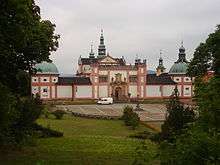
- Svatá Hora – Baroque church and monastery at a pilgrimage site, connected to the town with unique roofed stairs;
- Tomás Garrigue Masaryk Square:
- The St. Jacob church (founded 1298, baroque aisle, 19th century Neo-Gothic tower),
- Former court building (decorated with sgraffiti from Mikoláš Aleš mining drawings),
- Town library and other historic buildings;
- Town Hall – Neo-Renaissance building from 1890, architect Václav Ignác Ulmann;
- Zámeček-Ernestinum – castle founded in the 14th century, later archbishop residence, now culture centre, original gothic bay
- Memorial of victims of World War I, statue of archbishop Arnošt of Pardubice (sculptor Ivar Kodym);
- Pražská street – precinct with shops and restaurants, on the top end, the St. Wenceslas square (Czech: Václavské náměstí) is located with a statue "St. Wenceslas" (in Czech sv. Vaclav)] of the granit-diorit (1998, sculptor prof. Stanislav Hanzik);
- Jiráskovy sady (English: Jirásek Parks) – the park in the center of the old town, surrounded by historical buildings:
- The convent (ecclesiastical school), former mining academy rectorate or Příbram district office, architect V. I. Ulmann,
- Statue memorial to Alois Jirásek literature work (sculptor Václav Šára), bust of general Richard Tesařík;
- Příbram cemetery – graves of many Příbram natives, memorial of 1892 St. Mary mine disaster victims (the duplicate one is located in the Zdaboř cemetery), memorial of the Red Army World War II victims;
- Antonín Dvořák bust on the Dvořák Front (Czech: Dvořákovo nábřeží).
Landmarks in the new town, built after 1945:
- House of Culture – built in 1959, architect V. Hilský, house of Příbram theatre,
- Near is a statue of Antonín Dvořák (sculptor Josef Wagner);
- Statue of a Miner (sculptor L. Lošák) at the Příbram gymnasium
Landmarks in Březové Hory:
- Five historical mines and other buildings of the Mining Museum Příbram;
- St. Adalbert church – Neo-Renaissance, built in 1889;
- St. Prokop church – found on a place of old wooden campanile in the 18th century;
- Church of Master Jakoubek of Stříbro Charge – built in 1936.
Culture
Due to the notable levels of education and cultural interactions in the town, Příbram was nicknamed Brdy Athens (Czech: Podbrdské Athény) at the end of the 19th century. The town's culture was then largely influenced by the mining industry, which went on until the late 20th century. Mining life was described by poets and writers Fráňa Kučera, Quido Maria Vyskočil and František Gellner, who lived or studied in Příbram. Many books by Příbram's most famous writer, Jan Drda, were inspired by Příbram and he used the names of the town's neighbouring villages in his tales. Some of the stories in his Němá barikáda (English: Silent Barricade) have their origin in Příbram (especially Vyšší princip – see Modern History) while his Městečko na dlani (English: Town on Palm) describes Příbram directly, although reality is distorted there by having a river flowing through the town, which is named Rukapáň (English: God's Hand) in the book.
The town library was opened in 1900.
The theatre in Příbram has a long history thanks to a long tradition of theatricals. During the struggle to build the permanent theatre stage, the plays had to be performed in different halls for a long time, especially in the Sokolovna, the hall of Příbram Sokol. In 1959 the House of Culture (Czech: Kulturní dům) was built, which hosts the Příbram theatre and includes a cinema hall (the only other cinema is the open-air stage, while two pre-1989 more cinema-halls were closed). The first cinema productions were however held in Příbram as early as in 1914. The Příbram theatre is a permanent scene with a professional ensemble, its repertory is enriched by regular on-tour performances by Prague's and other cities ensembles. The reputation of Příbram ensemble is derived not only from departure of several actors to bigger ensembles, but also from the nationwide successful spectacle of Hrdý Budžes (English: Proud Budžes), a comedy play after book of Příbram born Irena Dousková. Barbora Hrzánová won the Thalia award as the best Czech female stage actress of the 2004 year.
Musical life of Příbram is connected to the name of Antonín Dvořák, who had his summerhouse in near Vysoká u Příbramě and visited Příbram often. In 1969, the Antonín Dvořák Music Festival was founded in Příbram, which has been organized annually until now, bringing domestic as well as foreign musicians and ensembles to the town and its neighbourhood. Příbram has its own amateur philharmonic orchestra, the Příbram Big Band still helds its concerts, miners‘ bands perform during annual miners‘festivals, the newest form of musical performances was brought to Příbram with the Ensemble of Svatá Hora Horn-Blowers.
The most important form of the town's musical activities was the choir singing. Starting with the Lumír-Dobromila association, founded and directed by composer, choirmaster and choral director Bohumil Fidler for fifteen years, and continuing as the Příbram Mixed Choir, the ensemble made a great impact on several generations of Příbram citizens. The most important choir leaders were Antonín Vepřek and his son, Vladimír. In 1939, Antonín Vepřek founded Příbram Children Choir, which is one of the oldest children choruses in the Czech Republic. Several children choruses are organized in Příbram elementary and art schools, where the town hosts annual international show of children choruses.
Popular music is played in several clubs in Příbram, with the Junior club the oldest of them. Of the Příbram music groups, the E!E punk rock band is the most important.
Miners in Příbram used to earn more money by handicrafts (embroidery, woodcarving, painting etc.), often on good artistic level. The Christmas cribs-making (Czech: betlém) lives until today, the museum collects also several mechanical models of mine. Of the professional artists, painter and graphic artist Karel Hojden, pupil of Max Švabinský was the most important. The world-known photographer of the first half of the 20th century František Drtikol was born in Příbram. The town gallery, which now seats in Zámeček-Ernestinum, former Prague archbishop's residence, is named after him and offers permanent exhibition of his works.
The Příbram museum was founded in 1886 and after several changes of form it is now run by the Central-Bohemian Region and named Mining Museum Příbram. It is the biggest museum of its kind in the Czech Republic, it contains the objects of historical mine with old headstock, miner's house, drift with a mining train, exhibition of mining history, geological collection and others.
Education
Příbram was the site of the Mining University, the tradition of which still continues today however the institution was moved to Ostrava in 1945. For more information about the university see below.
With the removal of the Mining University, Příbram lost the status of university town. In the 1990s, the town authorities aspired for the status again. In 2005 the College of European and Regional Studies (Czech: Vysoká škola evropských a regionálních studií, VŠERS) with seat in České Budějovice opened its affiliate in Příbram, with 30 students in the courses.[10]
There were news of another university department opened in Příbram in 2006 autumn, specialized on correspondence course of physical therapy.[11]
High schools offer in Příbram includes two gymnasiums, technical school, business academy, medical school and training college. Gymnasium Příbram was founded 1871 and serves as a general educational propaedeutics institutions for applicants for university studies. The Pod Svatou Horou gymnasium was founded in the 1990s. The technical school was derived from the preliminary courses of the Mining University, so called Mining School, founded already in 1851. In 2006 the school had 564 students.[12]
Seven elementary schools are in Příbram, six of them with traditional educational program (the number was reduced by two in the 1990s). The remaining one, found in 1991, stands on the Waldorf education program and it has also opened its own high school.
The town has 13 kindergartens and runs also two musical and art schools.[13]
Mining University in Příbram (1894–1945)
(see also Technical University of Ostrava)
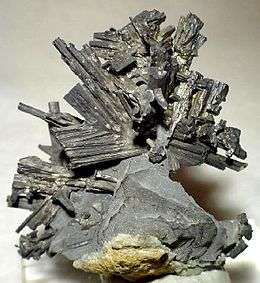
Mining education in Příbram dates from the beginning of the 19th century. The School of Mines was founded in 1851 and it was changed to Mining Academy in 1865. It was then the only mining educational institution in the Czech lands. The academy struggled in the shadow of Leoben academy, which repeatedly obtained its privileges in advance.
Important professors and lecturers of this era include:
- Geologist František Pošepný: one of the most important educators in the 19th century and of all the school's history;
- Mine surveyor (German: Markscheider) Gustav Ziegelheim: Professor for mining, ore processing and mine surveying as of 1882, Director of the School of Mines from 1883 to 1885 and from 1889 to 1895.[14]
In 1894, the academy received its university status decree and A. Hoffmann was elected the first chancellor of the university in 1898.
At the beginning of the 20th century the national conflicts lead to attempts to move Leoben academy to Vienna, while the Příbram school should have been dissolved. Long proceedings and the fact, that three quarters of the mining production of the Austria-Hungary was provided by the mines in the Czech lands, resulted in keeping both mining schools (Leoben and Příbram) alive. In 1904 both Leoben and Příbram institutions were renamed Mining Academy (Czech: Vysoká škola báňská) with prof. Josef Theurer as the first chancellor.
The university started with 11 departments, but the number grew to 18 in 1924. The university had the right to name doctors of mining sciences (dr. mont.). The highest number of students was almost 500 in 1921, but in the late 1930s the number fell to 120.
The position of the institution changed basically after arousal of Czechoslovakia in 1918, one year later the Czech language became the official language of the university. Many attempts to move it out of Příbram recurred, several of them initiated from the university itself, but they were refused.
World War II and the closure of Czech universities interrupted the work of the institution, which was resumed in 1945. The university was however moved to Ostrava within few months to bring the education closer to the booming mining industry in the Ostrava region. The last mining university students left Příbram in 1946 summer.[15]
Sports
Příbram is the home of 1. FK Příbram football club, successor of past Dukla Prague. The top division games have been played at the Na Litavce Stadium since 1997. The other Příbram's football club Spartak (also called Horymír) plays regional competition.
Příbram's volleyball club Vavex Příbram, found in 1935, has been a member of the Czech top division since 1998.
The ice hockey club entered regional league in 2006. The town is regular host of a town run, several road cycling races including the Grand Prix of Příbram. The Rallye Příbram (former Rallye Vltava) used to be part of the European Championships, now is the integrant part of the national championships. The movement of the little football plays a major role in the sport for all in the town and region organizing regular long-term competitions twice a year for almost 50 teams.
Besides the Na Litavce Stadium, the sport facilities in Příbram include two indoor ice rinks (main arena for approx. 5,000 spectators opened in 1978), indoor sports arena (opened 1978, capacity enlarged in reconstruction in 2005), modern open-air and indoor swimming pool and several playgrounds and tennis centers. Many of the Příbram's elementary schools have their sport-oriented classes and they have sports facilities like the high schools in the town.
Notable people
- Arnošt of Pardubice (1297–1364), Archbishop of Prague, owner of the Příbram domain
- Bohuslav Balbín (1621–1688), writer and poet, lived here
- František Pošepný (1836–1895), geologist, director of the School of Mines in Příbram
- Gustav Ziegelheim (1839–1904), professor for mining, ore processing and mine surveying, director of the School of Mines in Příbram[16]
- Bohumil Fidler (1860–1944), composer, choirmaster and choir director
- Jiří Baborovský (1875–1946), chemist
- František Gellner (1881–1914), Jewish poet
- František Drtikol (1883–1961), photographer
- Hermína Týrlová (1900–1993), animator and film director
- Adina Mandlová (1910–1991), actress
- Jan Drda (1915–1970), writer
- Richard Tesařík (1915–1967), general and war hero
- Josef Doležal (1920–1999), athlete
- Josef Vacek (born 1959), politician
- Ivan Fuksa (born 1963), politician
- Martin Švejnoha (born 1977), footballer
- Patrik Štefan (born 1980), ice hockey player
- Tomáš Zápotočný (born 1980), footballer
- František Rajtoral (1986–2017), footballer
- Tomáš Pilík (born 1988), footballer
- Jiří Veselý (born 1993), tennis player
Příbram meteorite
The town was the impact site of the Přibram meteorite in 1959. This was the first meteorite whose trajectory was tracked by multiple cameras recording the associated fireball. Several fragments of it were found close to Příbram at the nearby village of Luhy.[17]
Twin towns – sister cities
References
- "Population of Municipalities – 1 January 2020". Czech Statistical Office. 30 April 2020.
- Richard Tesařík in the Czech Radio web article (in Czech)
- "Podbrdsko". www.mistopis.eu. Retrieved 2 October 2019.
- "Poznej Pribram" (PDF).
- “Totalita.cz” (in Czech)
- Parties and coalitions are listed according to their participation in the 2002 and 2006 elections, with 2006 logos. The results are cited according to the Czech Statistical Office electoral web.
- www.volby.cz, Czech Statistical Office web for 2010 elections
- The abbreviation a.s. (Czech: akciová společnost) stands for joint stock company, abbreviation s. r. o. (Czech: spolčnost s ručením omezeným) stands for limited liability company
- "Veřejná databáze: Nezaměstnanost v obcích vybraného SO ORP". Czech Statistical Office.
- College of European and Regional Studies news webpage Archived 2007-01-13 at the Wayback Machine (in Czech)
- interview with VŠERS director V. Kříž
- Technical school Příbram history webpage Archived 2007-07-26 at the Wayback Machine (in Czech)
- Town of Příbram official site education webpage (in Czech)
- H. G., Professor Gustav Ziegelheim (Nekrolog). In: Österr. Zs. f. Berg- und Hüttenwesen, 23 (1904), S. 105–106
- Section composed after the Technical University of Ostrava history webpage (in Czech) Archived August 13, 2006, at the Wayback Machine
- H. G., Professor Gustav Ziegelheim (Nekrolog). In: Österr. Zs. f. Berg- und Hüttenwesen, 23 (1904), S. 105–106
- "Multiple fall of Příbram meteorites photographed" by Z. Ceplecha, Bull. Astron. Inst. Czechoslovakia, 12, 21-46, NASA ADS
- "Partnerská města – Město Příbram" (in Czech). Město Příbram. Retrieved 26 March 2020.
Bibliography
- ČÁKA, Jan Kráčím starou Příbramí. Příbram : Olšanská & Hyšpler, 1998. 83 p. ISBN 80-902362-1-9.
- VELFL, Josef. Příbram v průběhu staletí. Příbram : Městský úřad, 2003. 166 p. ISBN 80-239-1174-0.
External links
| Wikimedia Commons has media related to Příbram. |
- Municipal website
- Chisholm, Hugh, ed. (1911). . Encyclopædia Britannica. 22 (11th ed.). Cambridge University Press. p. 313.
